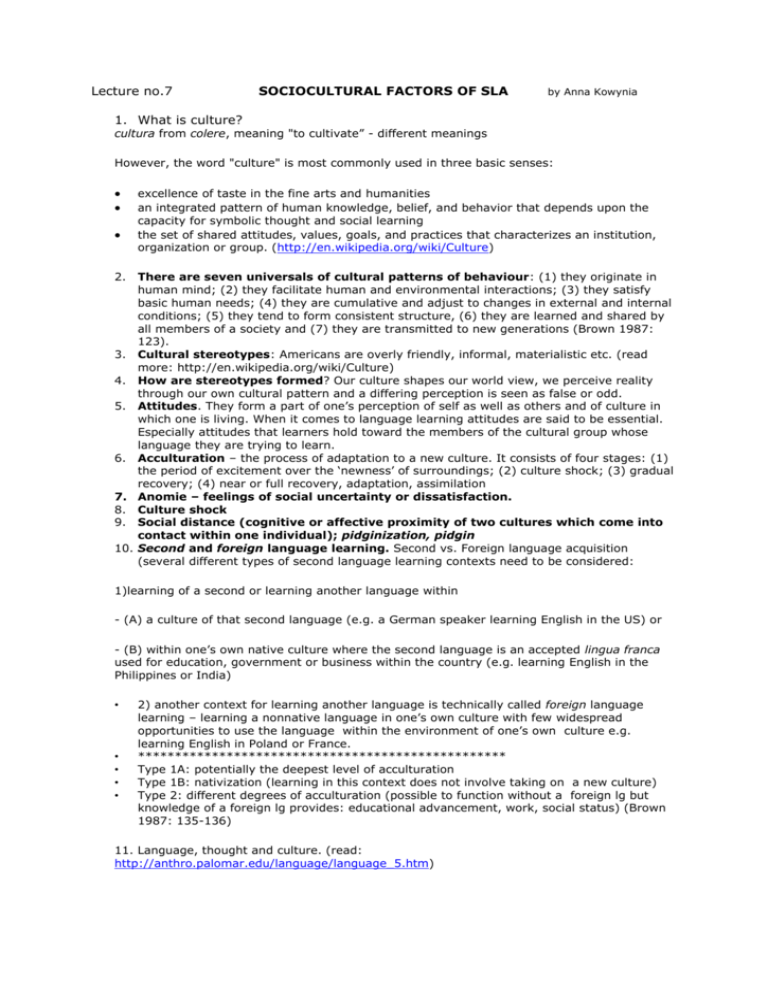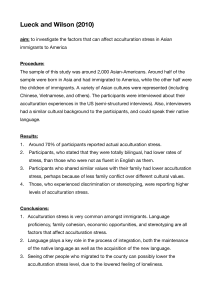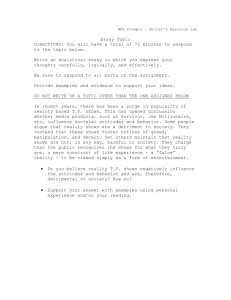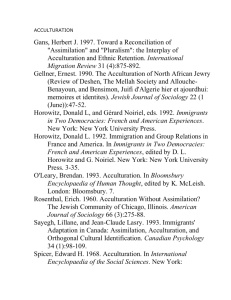Lecture no - Serwis Informacyjny WSJO
advertisement

Lecture no.7 SOCIOCULTURAL FACTORS OF SLA by Anna Kowynia 1. What is culture? cultura from colere, meaning "to cultivate” - different meanings However, the word "culture" is most commonly used in three basic senses: excellence of taste in the fine arts and humanities an integrated pattern of human knowledge, belief, and behavior that depends upon the capacity for symbolic thought and social learning the set of shared attitudes, values, goals, and practices that characterizes an institution, organization or group. (http://en.wikipedia.org/wiki/Culture) 2. There are seven universals of cultural patterns of behaviour: (1) they originate in human mind; (2) they facilitate human and environmental interactions; (3) they satisfy basic human needs; (4) they are cumulative and adjust to changes in external and internal conditions; (5) they tend to form consistent structure, (6) they are learned and shared by all members of a society and (7) they are transmitted to new generations (Brown 1987: 123). 3. Cultural stereotypes: Americans are overly friendly, informal, materialistic etc. (read more: http://en.wikipedia.org/wiki/Culture) 4. How are stereotypes formed? Our culture shapes our world view, we perceive reality through our own cultural pattern and a differing perception is seen as false or odd. 5. Attitudes. They form a part of one’s perception of self as well as others and of culture in which one is living. When it comes to language learning attitudes are said to be essential. Especially attitudes that learners hold toward the members of the cultural group whose language they are trying to learn. 6. Acculturation – the process of adaptation to a new culture. It consists of four stages: (1) the period of excitement over the ‘newness’ of surroundings; (2) culture shock; (3) gradual recovery; (4) near or full recovery, adaptation, assimilation 7. Anomie – feelings of social uncertainty or dissatisfaction. 8. Culture shock 9. Social distance (cognitive or affective proximity of two cultures which come into contact within one individual); pidginization, pidgin 10. Second and foreign language learning. Second vs. Foreign language acquisition (several different types of second language learning contexts need to be considered: 1)learning of a second or learning another language within - (A) a culture of that second language (e.g. a German speaker learning English in the US) or - (B) within one’s own native culture where the second language is an accepted lingua franca used for education, government or business within the country (e.g. learning English in the Philippines or India) • • • • • 2) another context for learning another language is technically called foreign language learning – learning a nonnative language in one’s own culture with few widespread opportunities to use the language within the environment of one’s own culture e.g. learning English in Poland or France. ************************************************** Type 1A: potentially the deepest level of acculturation Type 1B: nativization (learning in this context does not involve taking on a new culture) Type 2: different degrees of acculturation (possible to function without a foreign lg but knowledge of a foreign lg provides: educational advancement, work, social status) (Brown 1987: 135-136) 11. Language, thought and culture. (read: http://anthro.palomar.edu/language/language_5.htm)











